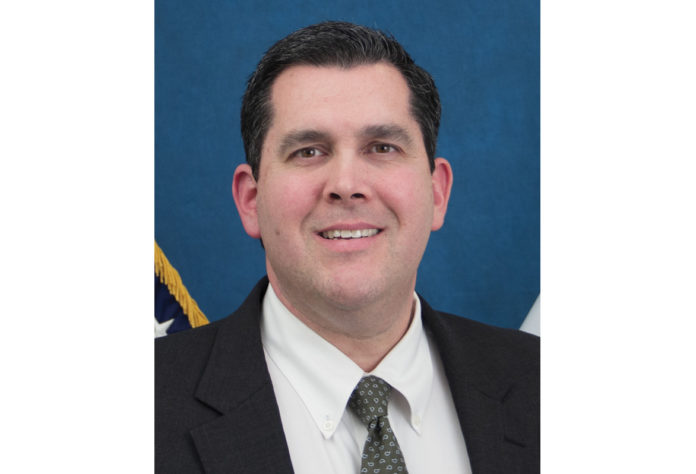E. Sequoyah Simermeyer is Chairman of the National Indian Gaming Commission where he oversees the Commission’s operations, ensuring regulatory compliance of more than 500 Indian gaming establishments across 29 states. As Chairman, he was appointed by the President and unanimously confirmed by the U.S. Senate in 2019. Indian Gaming magazine had the opportunity to speak with him at the recent G2E show in Las Vegas. Here is what he had to say…
What are the main responsibilities and priorities of the National Indian Gaming Commission (NIGC) in overseeing tribal gaming operations?
Our role is defined by the 1988 Indian Gaming Regulatory Act, and it established the agency as the federal regulatory component to Indian gaming. That regulatory framework for all of Indian gaming is very unique to that part of the gaming industry. It’s unique in part because there are multiple jurisdictions having different responsibilities. For the National Indian Gaming Commission, we as regulators share the same responsibility, whether it’s tribal regulators or other parts of the industry, with making sure that tribal assets are protected.
Some of the things that are unique to the federal regulatory role are approving ordinances that tribes pass for their gaming operations, and in the case where there’s management, reviewing and approving a management contract. We also provide minimum internal control standards through our regulations that apply for Class II operations, as well as for technical standards for devices. In a nutshell, that’s a good chunk of our footprint, but we’re also heavily involved in other aspects that go beyond just the game classification, including training and technical assistance as a direct part of our legislative charge of the work that we do. And in recent years, we’ve grown that to have as broad a reach as we can and really focused on what’s been the compliance approach for the NIGC in recent years, which is voluntary compliance.
Another important part of our responsibility includes enforcement actions when necessary, and those can be brought for a violation of the Indian Gaming Regulatory Act. Actions can be brought for violation of the NIGC’s regulations or the tribe’s own gaming ordinance. Those are also a component to ensuring good compliance.
Does the NIGC offer strategic guidance and assistance to tribal leadership and its gaming commission/regulators regarding compliance?
That’s a really important part of the regulator’s relationship – helping tribal leadership to understand what the policy objectives and outcomes of the lawmakers are, and for the regulators to find the best approach to carrying out and meeting those obligations. We provide broad trainings for new commissioners and new tribal councils. A lot of our training and technical assistance is targeted to the senior leadership in the operation. We have a national training topic of the month that we provide virtually, and that’s been a really successful way to reach an entire department within a regulator’s jurisdiction.
We also have site-specific training to address specific audit concerns a tribe may be having at their operation or with the regulatory body. And increasingly in recent years, we have focused on IT vulnerability assessments, which are an initial site-specific assessment of IT risk. There’s a number of different tools that we can provide to help ensure voluntary compliance and help leadership anticipate what direction they want it to go and understand what the responsibilities are.
The NIGC has a unique position at the intersection of federal and tribal governance. How do you navigate the complexities of this role to serve both tribal interests and federal oversight?
The 1988 Indian Gaming Regulatory Act really defines what lawmakers set forward and what the objectives are, and those objectives are our responsibilities as regulators to carry out. It’s important to stay true to and be transparent about what our role and responsibility is. It’s also important that as a regulatory community, we collaborate and try to find opportunities to support the work that we are doing, again, because we have that common responsibility to protect assets. What’s unique at the federal level is a responsibility to consult with tribal governments on a government-to-government basis.
We recently went through a series of eight public rulemakings, and there are a number of topics that we covered over the last 18 months. An important component to that was consultation sessions discussing with tribal leadership, or their representatives, what the potential impact of an agency action would be on their ability to govern. It’s a very important responsibility for federal agencies to engage in consultation so there’s an awareness of what a potential impact might be, but also to be sure that there’s meaning given to the federal tribal relationship, which is a very unique and an important part of our government relationship.
Are there any specific legislative or regulatory changes on the horizon that could impact tribal gaming, and if so, how is the Commission preparing for them?
As I mentioned, we recently we went through about eight different rulemakings. Some of the topics that we covered include providing more opportunities through the self-regulation certification, trying to be more transparent about the requirements for ordinance submissions, and aligning our regulations to be more focused on local level risk with small and charitable operations. We’re really looking at making sure that the regulations are keeping pace with how the industry is evolving and how risk might be changing, especially at the local level – that’s oftentimes where the best solutions are for monitoring that.
One of the last rules that we published dealt with the topic of key employees and primary management officials that are backgrounded and licensed at the tribal level. That one is part of a bigger effort that looks to do things like remove outdated salary thresholds for requiring licensing. It looks to provide for more secure policies for transferring and sharing criminal history record information that is part of background licensing programs. And it also really gives tribal leadership the opportunity to assess now, after 20 to 30-plus years of local level tribal regulation – particularly in the background and licensing part of the work that they do – if there is an opportunity to align resources and policies where risk exists. This may be much different than it was 10, 20, 30 years ago. That’s one area where the regulatory community has had a lot of focus. NIGC’s able to make these changes because of the tribal regulatory community and tribal leadership engaging with us on this, and I think that will be an area where tribes can continue to build out and grow.
Can you speak on the current cybersecurity issues. Is that something the NIGC can help the tribes with?
We saw, particularly during the pandemic, a real uptick in the sophistication of ransomware attacks. Through our training technical assistance program, I mentioned our IT vulnerability assessments, we issued threat alerts. We developed a number of partnerships with federal agencies and subject matter experts, in particular the Cyber Infrastructure Security Agency (CISA). We’re trying to really harness, leverage and share those resources throughout the Indian gaming community and beyond to message the importance of preparing, not deferring important decisions, but instead have a forward-looking plan to address cybersecurity.
The gaming industry, broadly, is not unlike any other industry that’s been going through this. It’s a challenge, and it’s something that I think regulators can provide a unique role in highlighting best practices and encouraging conversations across jurisdictions – whether it’s state regulators, tribal regulators or the federal regulator – just sharing information about how we can best manage and mitigate that risk. We deal with it ourselves as a federal agency, making sure that we are up to date, secure, and that our own policies are being updated as necessary.
Do you have any comments on the recent anniversary of the Indian Gaming Regulatory Act?
October 17th is the date in 1988 when the Indian Gaming Regulatory Act was enacted, so it’s now been 35 years. It’s a great opportunity to talk about the trajectory of Indian gaming’s success. Earlier this year, we reported on the 2022 national gross gaming revenue for Indian gaming. It tells a story of the unique relationship between the tribal regulatory bodies, tribal leadership, and their operations in making a long-term commitment to using the resources provided by Indian gaming in a way that best serves their communities – whether it’s through job creation, providing social welfare programs that are much needed in communities, bolstering regional economies, or developing relationships with local jurisdictions. There are a lot of successes that have come out of these areas.
The act itself compromised a lot of different positions when it was passed, and it created a new federal regulatory role. It created certain requirements that make Indian gaming unique and unlike any other type of gaming, including game classifications and certain oversight from the federal level and restrictions on specific uses for revenue.
This is also a good opportunity to look at how we are developing a balanced approach to be efficient and effective in the regulatory community, and where we are focusing our regulatory oversight to make sure we are prepared for the next 35 years of what Indian gaming is offering.














































